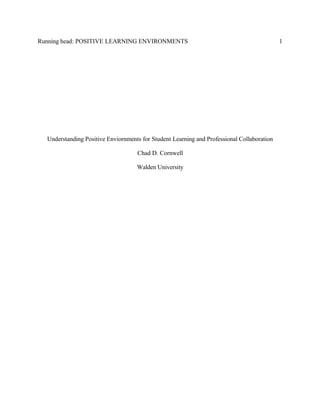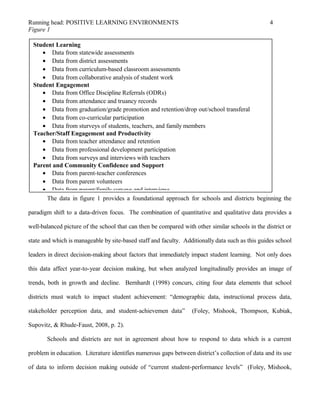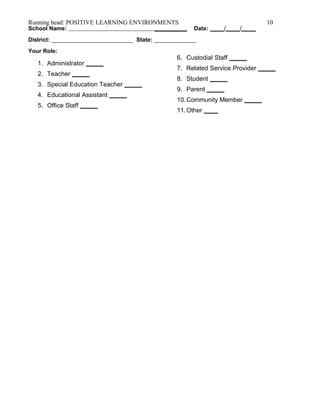This document discusses using data to drive instruction in Title 1 schools. It emphasizes that data about teacher-student relationships, discipline, attendance, climate and resources can guide administrators and educators. An effective data plan considers factors impacting student learning, collects and analyzes different types of data, and uses the analysis to inform decisions. The document also stresses that schools need resources to properly collect and analyze data, especially behavioral data, and they must implement changes based on the data analysis for it to be effective.













![POSITIVE LEARNING ENVIRONMENTS
References
(Please note that the following references are intended as examples only.)
Alexander, G., & Bonaparte, N. (2008). My way or the highway that I built. Ancient Dictators,
25(7), 14-31. doi:10.8220/CTCE.52.1.23-91
Babar, E. (2007). The art of being a French elephant. Adventurous Cartoon Animals, 19, 4319-
4392. Retrieved from http://www.elephants104.ace.org
Bumstead, D. (2009). The essentials: Sandwiches and sleep. Journals of Famous Loafers, 5, 565-
582. doi:12.2847/CEDG.39.2.51-71
Hansel, G., & Gretel, D. (1973). Candied houses and unfriendly occupants. Thousand Oaks, CA:
Fairy Tale Publishing.
Hera, J. (2008). Why Paris was wrong. Journal of Greek Goddess Sore Spots, 20(4), 19-21. doi:
15.555/GGE.64.1.76-82
Laureate Education, Inc. (Producer). (2007). How to cite a video: The city is always Baltimore
[DVD]. Baltimore, MD: Author.
Laureate Education, Inc. (Producer). (2010). Name of program [Video webcast]. Retrieved from
http://www.courseurl.com
Sinatra, F. (2008). Zing! Went the strings of my heart. Making Good Songs Great, 18(3), 31-22.
Retrieved from http://articlesextollingrecordingsofyore.192/fs.com
Smasfaldi, H., Wareumph, I., Aeoli, Q., Rickies, F., Furoush, P., Aaegrade, V., … Fiiel, B.
(2005). The art of correcting surname mispronunciation. New York, NY: Supportive
Publisher Press. Retrieved from
http://www.onewaytociteelectronicbooksperAPA7.02.com
14](https://image.slidesharecdn.com/1f938d9e-be46-4769-ad8b-636886fcea04-160118164123/85/MA2and8CCornwell-14-320.jpg)
